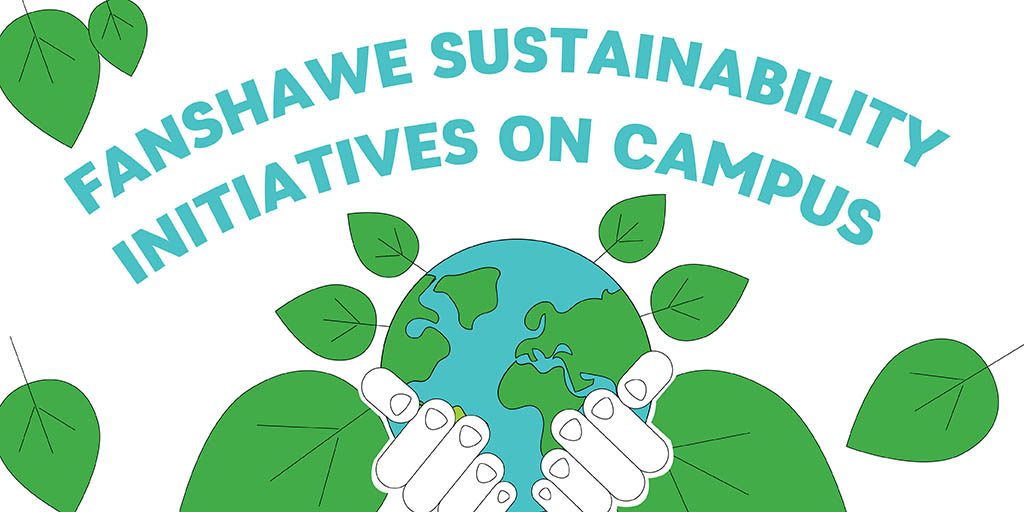Fanshawe sustainability initiatives on campus

The sustainability duo, Ivan Walker and Amanda Whittingham, are the fix it, clean it, park it and green it people at Fanshawe. Walker has been the Senior Manager, Facilities Operations and Sustainability for five years and Amanda Whittingham has been the Sustainability Coordinator for two years. They are responsible for creating a sustainable campus by embracing social and environmental responsibility and educating students on how to be more environmentally conscious. Fanshawe sustainability has a number of projects on the go including recycling and waste reduction, saving energy, water conservation and more.
Recycling and Waste Reduction
Fanshawe sustainability is dedicated to reducing the amount of waste that goes to the landfill. The containers on campus feature four different streams including containers, paper, organics and landfill. Each container shows graphics of what items can be put into each bin in order to educate students and faculty on proper recycling methods. “These bins prevent stuff from going to the landfill which is what we do not want,” Walker said. “50 per cent of the items we put in the landfill do not belong there which is why it is important for us to educate students on proper waste diversion”. In 2016, 41.1 per cent of Fanshawe’s waste was recycled, composted or reused and Fanshawe sustainability has goals to continue increasing this number.
“We are also recycling cigarette butts which get made into picnic tables and benches, concrete that comes out of our student programs, electronics and clothes,” Walker said. Another waste reducing initiative that Fanshawe does are the bottle fill stations that work to promote reusable water bottles opposed to plastic bottles. Fanshawe has recently added a number of new bottle fill stations and are planning to continue adding more throughout the campuses.
Saving Energy
In the summer Fanshawe introduced three solar-powered picnic tables (D and F/SUB courtyards) and two solar-powered bench arches (T and F bus stops) where students can charge their electronic devices. According to Walker, each unit is made from recycled materials and there is enough power stored in them so they can be used all day and light the area at night. In addition to these solar-powered tables and bench arches, this year Fanshawe finished the first solar production array at the college consisting of 324 solar panels located on top of H building. “The solar panel array is offsetting the greenhouse gasses that are in the generation of hydro and gives us an opportunity to get free energy from the sun,” Walker said. “It will save between $24,000 and $28,000 a year in hydro and have a huge long term payback”. Walker discussed that one of the paybacks of the solar-powered array is the research center where students in the sustainability program can observe the effects of the solar panels and determine how to adjust the angles to generate different levels of power. In another effort to save energy at Fanshawe, three of the oldest buildings (B,C and D) will be upgraded. “We are going to be equivalently wrapping these buildings with a scarf, called a building envelope, where we will add insulation and better windows to reduce the utility usage,” Walker said. “These buildings currently have single paned windows which are the most inefficient windows you can have”.
Water Conservation
According to Walker, Fanshawe’s water usage has been on a decline since 2013 even though the student population and building space has increased. Z building contains two storage tanks where rainwater is collected and then used to flush toilets and urinals and for site irrigation. Grease traps have been added in the kitchens in order to keep the plumbing and sewage systems clean and functioning properly. In addition to this, water saving components such as low flow toilets have been added into student residences and Fanshawe saw a water consumption decrease of 38.8 per cent in residence four and 44.6 per cent in residence one between 2011 and 2016. This year, Fanshawe sustainability plans to do water meter monitoring to determine where else the college can decrease water consumption.
What Students Can Do
According to Walker there are a number of things students can do to help the environment including carpooling, taking the bus, recycling, eating local food and minimizing your energy usage both at the school and at home. Fanshawe sustainability understands that some students already make these active choices while others need more education which is why each semester they visit classrooms to inform students on what they can be doing to help the environment. “It is all in the choices that students make every day that can make a difference,” Walker said. “It is up to our generation and the next generation to fix and mitigate all of the negative things that have been done to the earth in the last 50 years on earth”. Walker encourages students who have ideas for sustainability initiatives or locations where they want to see bottle fill stations to email sustainability@fanshawec.ca.














